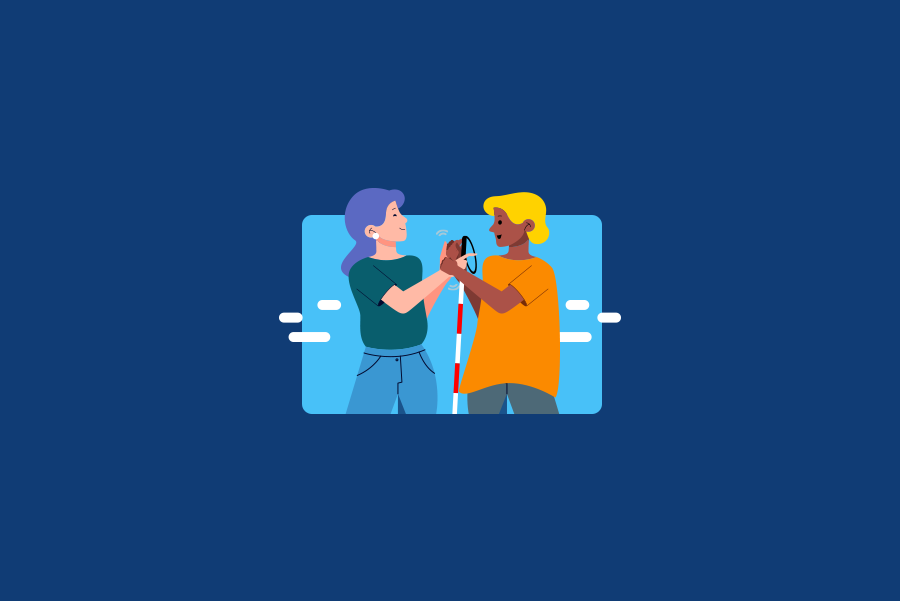
What is deafblindness?

Maybe you’ve already come across this term before somewhere, but don’t know exactly what it means. Or perhaps you understand it, but still have many questions about this disability. Don’t worry, here in the text we’ll explain to you some more about what deafblindness is, its different types, and the most used means of communication by deafblind people 😉
Understanding deafblindness
As we mentioned above, deafblindness is a kind of disability that compromises people’s vision and hearing in different levels. It can also be called dual-sensory impairment, or multi-sensory impairment.
It’s important to highlight that in spite of associating two disabilities, deafness and blindness, deafblindness isn’t a mix of those two. Because it affects the two channels of communication humans use for remote information reception, it is considered an unique disability, with its own characteristics and challenges. With that in mind, the word deafblindness started being used in the 1990s, instead of the hyphenated term deaf-blind, to indicate a distinct disability.
Did you know that for a person to be considered deafblind they don’t necessarily have to be completely blind and deaf? This happens when the residue of one of these senses can’t compensate for the loss of the other. In other words, when low hearing can’t make up for visual loss. Or also when low vision can’t balance hearing loss.
There isn’t very precise information about the amount of deafblind people in the world today. Aside from affecting the depth of our knowledge regarding deafblindness, the lack of data also makes it difficult to create public policies that ensure these people have access to education, healthcare, leisure and work. Even so, there is still some information. The World Health Organization (WHO) estimates there are at least 40 thousand deafblind people around the world.
The different types of deafblindness
Basically, deafblindness can be categorized into two categories: congenital or acquired. People with congenital deafblindness are those who are born with the disability, or acquire it very early on, before developing any kind of communication. Now those with the acquired type, are people that became deafblind after learning a language, be it oral or Sign.
Besides that, deafblindness has its nuances. People with this disability aren’t necessarily born with both, or acquire the two throughout life. It’s possible, for example, to be born blind and acquire deafness later, or vice-versa.
The ways in which deafblind people communicate
Deafblind people can communicate in many different ways, and some of them you might have not even known about before. Here we’ll explain the main means of communication they use, check it out!
- Tactile ASL: it’s a way of communicating based on ASL (American Sign Language). The deafblind person interprets what is being said by someone, by putting their hands over the ASL signing. Communication in Tactile ASL happens in the US, while other countries use the tactile form of their own Sign Languages.
- Tactile Braille: it’s an alphabetical method based on Braille, in which the person interprets the Braille dots through tact.
- Typewriting Alphabet: basically typewriting can be considered the alphabet of Sign Languages. This way, the deafblind person feels the words being spelled out on their hands.
- Sign Language in a Reduced Visual Field: this way of communication is normally used by deaf people with low vision. This way, whoever talks to them positions themselves in their visual field, and signs in ASL.
- Tadoma: the deafblind person places their hands on the face and neck of whoever is talking. This way, they feel the vibration of the voice and mouth movements, and can interpret the message being transmitted.
- Alphabetical Cards: this form of communication consists of plastic boards, with letters and numbers in high relief, and in some cases contrasting colors as well. Deafblind people then communicate through tact.
- Alphabetical Cards in Braille: this way of communication has the same idea of the previous one, but instead of using the alphabet in high relief, it uses the numbers and letters in Braille.
- Amplified Speech: made for people that use Sound Amplification Devices. Communication happens via oral language, in a higher volume, close to the deafblind person’s ear.
- Amplified Writing: created for deafblind people with low vision, this way of communication presents letters in a bigger size and higher contrast, better showing the written words.
Aside from all these communication forms, deafblind people rely mainly on interpreter guide professionals. They are experts on communicating and supporting these people. Their job is mostly interpreting communication, visual description and the functions of a seer guide.
The deafblindness day
Annually, on June 27th, it’s celebrated the International Day of Deafblindness. Now, do you know why? This is the birth date of Helen Keller, a great symbol of resistance and defender of people with disabilities’ rights.
Helen was born deafblind, was alphabetized in Tactile Sign Language, and is the first person with this disability to graduate from university. She was also a writer, lecturer and a great activist in the United States.
It’s essential that a day exists to acknowledge, praise and give visibility for deafblind people. Commemorative dates like this one need to be remembered. They are the ones that encourage inclusion in society, promote debates on public policies, bring to light new information about the matter, and fight all forms of discrimination. Now that you know more about deafblindness, it’s your job to fight for the inclusion of these people and for breaking the barriers they have to face everyday. Be it learning ASL, thinking about the high contrast in your contents or even by being closer to people with this disability, it’s always possible to contribute to a more just and humane world.


